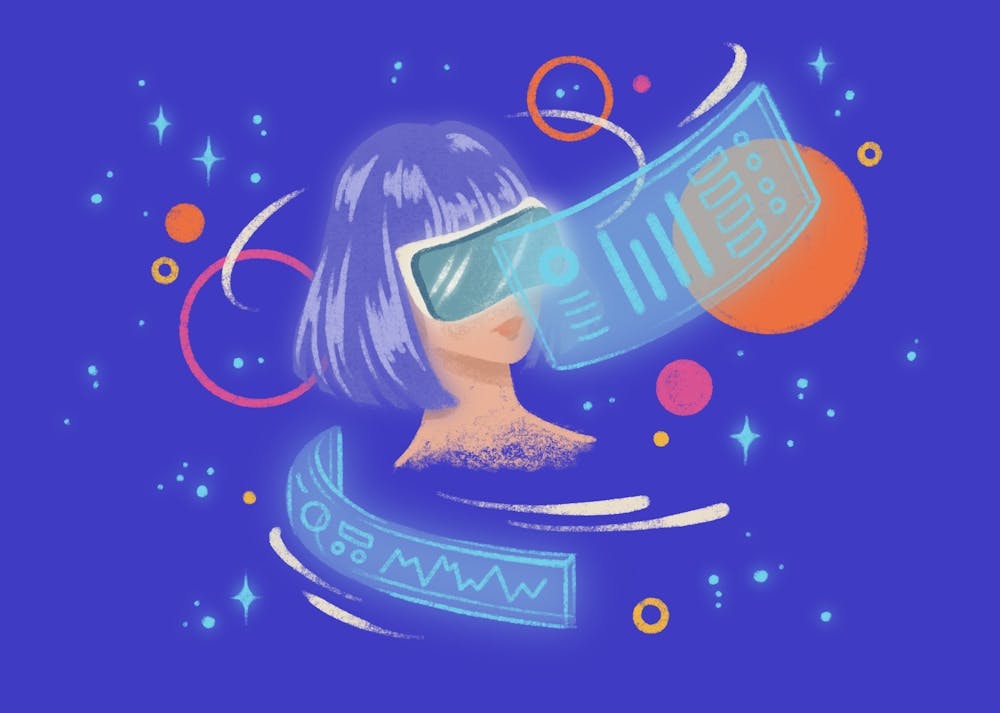Virtual reality technology is entering an era of greater application in a variety of fields, paving the way for more efficient learning and new ways to connect with others when it may not be possible to do so in person.
Extended reality, or XR, is a term that encompasses multiple forms of digital worlds, including virtual and augmented realities and mixed reality, which combines real-world and digital elements of AR and VR.
The amalgamation of these XR worlds into one virtual space is known as the metaverse, a term coined in 1992 by author Neal Stephenson in his sci-fi novel "Snow Crash." This platform would function similarly to the internet — users can move between digital worlds and interact with other users and the objects in the space.
Facebook changing its corporate brand to Meta and developing content to be used in the metaverse is opening the door for XR to become a norm in many fields.
Mina Johnson is a cognitive psychologist in the psychology department at ASU and the owner of Embodied Games, an VR gaming company that develops educational STEM content.
Johnson said she believes that VR will become vital to the learning environment in the coming years, and the only reason it hasn’t already is because of the high cost of entry, with pricey headsets and a lack of existing educational content in VR.
A Brave New Universe
Here at ASU, XR has been centered in research and development at the Learning Futures Collaboratory (LFC), led by Heather Haseley and Dan Munnerley.
The LFC is studying and creating technology for the future of education and teaching students in multiple disciplines about XR worlds and how to create them. Haseley said she feels this future is near, coming within the next three-to-five years.
"We're also going to be starting up another class where students expand virtual worlds, or Dreamscape virtual worlds, and start to make it more like … an open world," Munnerley said.
These virtual worlds will eventually be connected in one central virtual world, affectionately dubbed the "ASU-niverse" by Haseley and Munnerley.
Because students will be creating and expanding virtual experiences, then centralizing them on one metaverse-like platform, the "ASU-niverse" appears to be created by students, for students.
Aashiq Shaikh is a PhD student who created the Virtual Tutoring Simulation as a test to see how quickly that type of interactive content could be created. Shaikh said he can see the University’s program heading toward a larger XR experience.
"I see these sort of small baby steps and eventually, I think the University will be building the actual educational experiences and things like that," he said.
However, as with all new technology, there remain many questions about how ASU will tackle the issues of accessibility, privacy and safety.
Entering the ASU-niverse in its most immersive format would require a VR headset of some sort that is compatible with the platform, the cheapest of which costs $300. The steep financial barrier to entry into this student universe could mean excluding students who cannot afford a special, separate device.
Munnerley said LFC is working around this and is planning to render the worlds using cloud streaming, so the virtual world can be accessed on a PC or laptop. But the experience just wouldn't be the same.
Aside from the financial barrier, the next difficulty the team faces is accommodating all kinds of disabilities, including vision impairments, hearing impairments and physical disabilities.
Fully immersive VR currently requires users to be able to see, hear, walk around and use both arms to interact with their surroundings, so reasonable accommodations would have to be made in order for the "ASU-niverse" to be inclusive. Munnerley said these accommodations remain in consideration as they continue developing the virtual worlds.
Another complication facing the team is that of data security. Data privacy is highly important to online consumers — a 2019 Cisco survey of 2,600 adults in 12 of the world's largest economies found that 84% of participants care about their data privacy and want more control over their data.
As virtual worlds contain massive amounts of data about users' actions and interactions, there is much to be asked about how data will be stored and shared, and if it will be sold to third parties.
Munnerley said in an email that all projects created at the LFC are done so under the Family Educational Rights Privacy Act, Arizona law and ASU policy, and that they have no plans to sell data.
"We think this is the key to the successful growth and adoption of the Metaverse," the email said.
Arizona does not have comprehensive consumer data protection laws, but the state recently enacted a breach-notification law, meaning if a data breach or hack compromised consumers' personal information, the owner of the data must notify them within 45 days.
A Different Reality
With technology that can immerse users in a virtual world that isn't confined to the physical and societal limitations of the real world, finding solace through escapism is inevitable.
2020 created new challenges and amplified existing ones, which many people coped with by transporting themselves into a different, simpler reality. Popular simulation games like Minecraft expanded into the VR realm in 2020, giving avid players a third dimension to experience the game in.
Haptic suits can provide an additional dimension of interactivity, according to Johnson. These suits allow users to feel like they're not only immersed in a virtual world, they are truly within it, which could take VR escapism to a new level.
bHaptics is a company that creates haptic suits for gaming. Their latest model, TactSuit X40, uses 40 individual tactile motors to provide haptic feedback to players across a wide selection of games.
However, tactile immersion into the metaverse will cost users a lot — the TactSuit X40, which only covers the chest area, sells for $499 on the bHaptics online shop.
To gain the full-body experience, gamers would have to shell out $1,400 for the TactSuit and corresponding arm bands, leg bands, feet devices and a face cover, which doesn't include the price of a console, a VR headset or games.
VR becoming mainstream in the education sphere would create an excellent immersive learning experience, Johnson said, but she knows the cost of the headsets alone is the biggest barrier to entry.
Including an additional dimension with haptic suits would be an impossible feat for most schools, so VR immersion in education will have to be limited for now to what headsets alone can provide.
Still, the immersive experience shows promise in relation to students' academic performance. Munnerley said the LFC conducted a study in collaboration with the Action Lab at ASU that measured the difference in information retention levels between students who do virtual labs on a laptop and those who do them in VR.
Haseley said the initial results were "very, very promising," showing that the students who completed the lab in VR were able to answer more complicated questions on the material significantly better than the students who used a 2D version.
VR in a social context also appears very promising. With COVID-19 restrictions limiting in-person social interaction, many turned to these VR experiences to stay in touch with friends and meet new ones.
"I know that just personally, my brother is really involved and he's a bit shy," Haseley said. "But he has found some of his very best friends playing in some of these environments ... and really connected with them on a very human level."
In 2020, the LFC partnered with a remote collaboration company called Virbela to host a virtual campus that allowed the team to host remote events. The virtual space was laid out in a traditional auditorium format, Munnerley said.
"What you can do in Virbela that you can't do in Zoom is just get up and walk out, or walk to the back of the auditorium and talk to somebody in that, in that virtual space at the same time as the event was going on," he said.
Munnerley said that this feature of VR working helps combat Zoom fatigue — a phenomenon of increased burnout caused by working virtually for a long time — because users are able to move freely around the virtual space and interact with others in a more familiar way.
Real-world-adjacent socializing is a main component of both the "ASU-niverse" and the VR experience, Haseley explained.
"A lot of people just watch movies, and they just go to a virtual, you know, lounge … and they'll just sit in their avatars, and they'll throw popcorn at each other … because it's just a fun experience, you know, sharing that movie together," she said. "So I think doing those things socially, is so powerful for people who need that, need that connection."
Reach the reporter at cpedrosa@asu.edu and follow @_camila_aldana_ on Twitter.
Like The State Press Magazine on Facebook and follow @statepressmag on Twitter.
Continue supporting student journalism and donate to The State Press today.

Camila Pedrosa is the Editor-in-Chief for The State Press Magazine. This is her fifth semester working with the magazine, and she has previously written for Cronkite News, The Arizona Republic and The Copper Courier.




